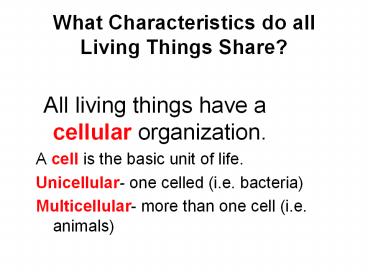What Characteristics do all Living Things Share? - PowerPoint PPT Presentation
1 / 19
Title:
What Characteristics do all Living Things Share?
Description:
One of the realities of life is that all life eventually comes to an end. ... Classification- the process of grouping things based on their similarities. – PowerPoint PPT presentation
Number of Views:339
Avg rating:3.0/5.0
Title: What Characteristics do all Living Things Share?
1
What Characteristics do all Living Things Share?
- All living things have a cellular organization.
- A cell is the basic unit of life.
- Unicellular- one celled (i.e. bacteria)
- Multicellular- more than one cell (i.e. animals)
2
Prokaryotes vs. Eukaryotes
- Prokaryotes are organisms that DO NOT have a
nucleus. Ex. Bacteria - Eukaryotes are organisms that have a nucleus. Ex.
Animals, humans, plants
3
- Cells are composed of chemicals.
- Water- the most abundant
- Carbohydrates- for energy
- Proteins and lipids- building materials
- Nucleic Acids- contain genetic material
4
- Living things react to stimuli.
- A stimulus is something in the environment
that causes a reaction, or a response. - A response is an action or change in behavior.
5
- Living things grow and develop.
- Growth- an increase in the size of an organism.
- Development- a progressive change in an organism
over time.
6
- All living things have the ability to reproduce.
- All living things arise from other living things.
7
The theory of Spontaneous Generation, which
proposed that life can appear spontaneously from
non-living things, was disproved by experiments
performed by Redi and Pasteur.
8
Life Comes from Life
- Living things come from living things.
- 400 years ago people though that living things
came from non-living things (Spontaneous
Generation). - Francisco Redi, Louis Pasteur did experiments to
disprove this theory.
9
Redis Experiment
10
Louis Pasteur
- Invented a process where bacteria could be
removed by boiling and then cooling liquid. Ex.
The milk you drink is pasteurized. - He also developed vaccinations for anthrax,
cholera, TB, smallpox, and rabies.
11
- All living things use energy.
- Energy is used to nourish, repair and create new
cells. - We obtain energy from converting the foods that
we eat into energy that can be used by the cells.
12
How do Organisms Obtain Food for Energy?
- Autotrophs- make their own food (Plants).
- Heterotrophs- obtain food from other sources.
(like us) - Herbivore- eat plants.
- Carnivore- eat animals (meat).
- Omnivore- eat plants and animals.
13
- All living things will die.
- One of the realities of life is that all life
eventually comes to an end. This process is
called Expiration.
14
What do All Living Things Need to Survive?
- Water
- Food (energy)
- Living space
- Stable internal conditions (Homeostasis)
15
Homeostasis
- The maintenance of stable internal conditions
despite changes in the environment (maintaining a
balance in your body.)
16
More terms
- Taxonomy- the scientific study of how living
things are classified. - Binomial nomenclature-
- Naming system in which each organism has a
two-part name. - Genus and species
- Ex Canis familiaris (dog)
17
- Stimulus- a change in an organisms surrounding
that cause an organism to react. - Response-a reaction to a stimulus
- Structure-the way an organism is made
- Ex Bacterial cells are rod-like.
18
- When classifying
- Use observable characteristics
- DNA
- Structure
- When they are closely related, they share the
same DNA.
19
- Classification- the process of grouping things
based on their similarities. - Why classify?
- Because its easier for scientists to study.

